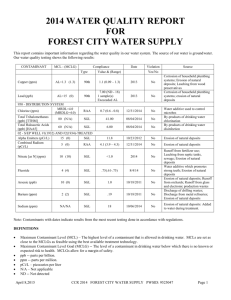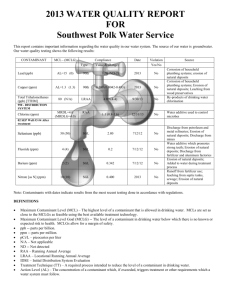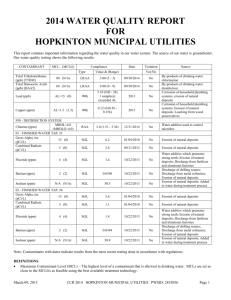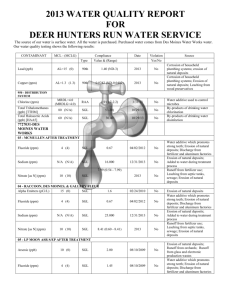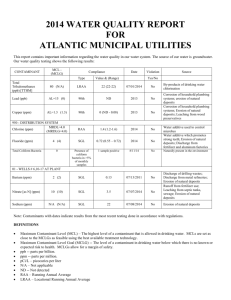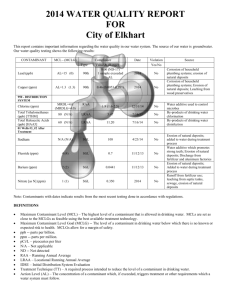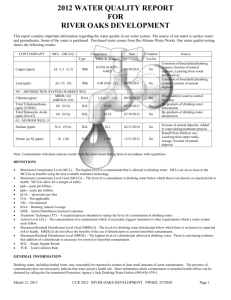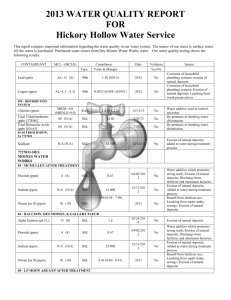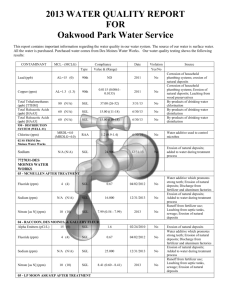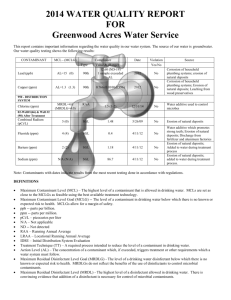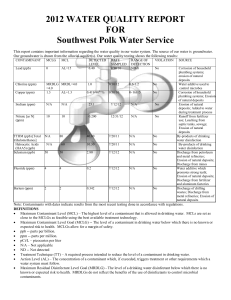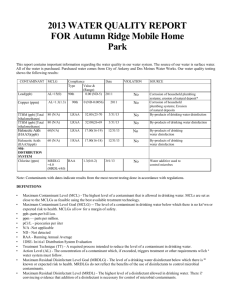2013 Consumer Confidence Report
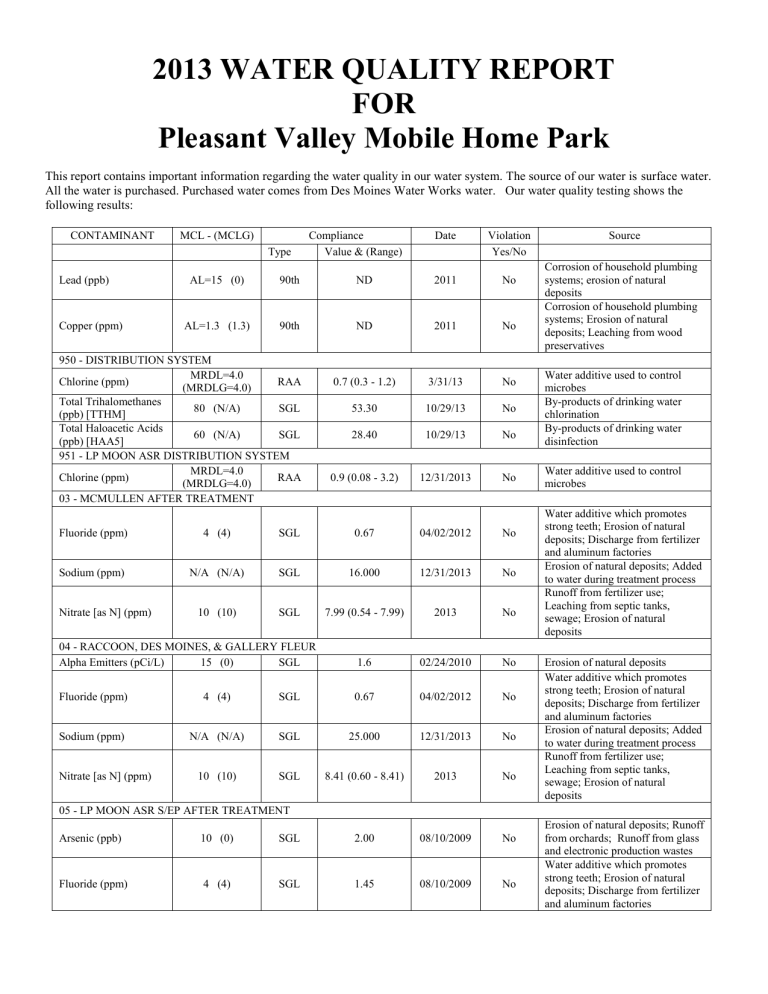
2013 WATER QUALITY REPORT
FOR
Pleasant Valley Mobile Home Park
This report contains important information regarding the water quality in our water system. The source of our water is surface water.
All the water is purchased. Purchased water comes from Des Moines Water Works water. Our water quality testing shows the following results:
CONTAMINANT MCL - (MCLG) Compliance Date Violation Source
Lead (ppb)
Copper (ppm)
AL=15 (0)
AL=1.3 (1.3)
Type
90th
90th
Value & (Range)
ND
ND
2011
2011
Yes/No
No
Corrosion of household plumbing systems; erosion of natural deposits
No
Corrosion of household plumbing systems; Erosion of natural deposits; Leaching from wood preservatives
950 - DISTRIBUTION SYSTEM
Chlorine (ppm)
MRDL=4.0
(MRDLG=4.0)
Total Trihalomethanes
(ppb) [TTHM]
Total Haloacetic Acids
(ppb) [HAA5]
80 (N/A)
60 (N/A)
RAA
SGL
SGL
951 - LP MOON ASR DISTRIBUTION SYSTEM
Chlorine (ppm)
MRDL=4.0
(MRDLG=4.0)
RAA
03 - MCMULLEN AFTER TREATMENT
0.7 (0.3 - 1.2)
53.30
28.40
3/31/13
10/29/13
10/29/13
0.9 (0.08 - 3.2) 12/31/2013
No
No
No
No
Water additive used to control microbes
By-products of drinking water chlorination
By-products of drinking water disinfection
Water additive used to control microbes
Fluoride (ppm)
Sodium (ppm)
Nitrate [as N] (ppm)
4 (4)
N/A (N/A)
10 (10)
SGL
SGL
SGL
0.67
16.000
7.99 (0.54 - 7.99)
04/02/2012
12/31/2013
2013
No
No
No
Water additive which promotes strong teeth; Erosion of natural deposits; Discharge from fertilizer and aluminum factories
Erosion of natural deposits; Added to water during treatment process
Runoff from fertilizer use;
Leaching from septic tanks, sewage; Erosion of natural deposits
04 - RACCOON, DES MOINES, & GALLERY FLEUR
Alpha Emitters (pCi/L) 15 (0) SGL
Fluoride (ppm)
Sodium (ppm)
Nitrate [as N] (ppm)
4 (4)
N/A (N/A)
10 (10)
SGL
SGL
SGL
1.6
0.67
25.000
8.41 (0.60 - 8.41)
02/24/2010
04/02/2012
12/31/2013
2013
No
No
No
No
Erosion of natural deposits
Water additive which promotes strong teeth; Erosion of natural deposits; Discharge from fertilizer and aluminum factories
Erosion of natural deposits; Added to water during treatment process
Runoff from fertilizer use;
Leaching from septic tanks, sewage; Erosion of natural deposits
05 - LP MOON ASR S/EP AFTER TREATMENT
Arsenic (ppb)
Fluoride (ppm)
10 (0)
4 (4)
SGL
SGL
2.00
1.45
08/10/2009
08/10/2009
No
No
Erosion of natural deposits; Runoff from orchards; Runoff from glass and electronic production wastes
Water additive which promotes strong teeth; Erosion of natural deposits; Discharge from fertilizer and aluminum factories
Sodium (ppm)
Nitrate [as N] (ppm)
N/A (N/A)
10 (10)
SGL
SGL
70.200
1.95 (1.12 - 1.95)
12/31/2013
2013
No
No
Erosion of natural deposits; Added to water during treatment process
Runoff from fertilizer use;
Leaching from septic tanks, sewage; Erosion of natural deposits
06 - MCMULLEN ASR S/EP
Fluoride (ppm)
Sodium (ppm)
Nitrate [as N] (ppm)
Atrazine (ppb)
4 (4)
N/A (N/A)
10 (10)
3 (3)
SGL
SGL
SGL
QSA
1.17
19.200
7.62 (3.89 - 7.62)
ND
08/10/2009
12/31/2013
2013
09/30/2012
No
No
No
No
Water additive which promotes strong teeth; Erosion of natural deposits; Discharge from fertilizer and aluminum factories
Erosion of natural deposits; Added to water during treatment process
Runoff from fertilizer use;
Leaching from septic tanks, sewage; Erosion of natural deposits
Runoff from herbicide used on row crops
07 - SAYLORVILLE S/EP (AFTER TREATMENT)
Barium (ppm)
Fluoride (ppm)
Sodium (ppm)
Nitrate [as N] (ppm)
2 (2)
4 (4)
N/A (N/A)
10 (10)
SGL
SGL
SGL
SGL
0.1
0.24
19.400
1.43 (0.06 - 1.43)
02/25/2011
03/25/2011
12/31/2013
2013
No
No
No
No
Discharge of drilling wastes;
Discharge from metal refineries;
Erosion of natural deposits
Water additive which promotes strong teeth; Erosion of natural deposits; Discharge from fertilizer and aluminum factories
Erosion of natural deposits; Added to water during treatment process
Runoff from fertilizer use;
Leaching from septic tanks, sewage; Erosion of natural deposits
Turbidity (NTU) N/A (N/A) TT
Enter highest single measurement and the lowest monthly percentage of samples meeting turbidity limits here.
Soil runoff
Note: Contaminants with dates indicate results from the most recent testing done in accordance with regulations.
DEFINITIONS
Maximum Contaminant Level (MCL) – The highest level of a contaminant that is allowed in drinking water. MCLs are set as close to the MCLGs as feasible using the best available treatment technology.
Maximum Contaminant Level Goal (MCLG) -- The level of a contaminant in drinking water below which there is no known or expected risk to health. MCLGs allow for a margin of safety.
ppb -- parts per billion.
ppm -- parts per million.
pCi/L – picocuries per liter
N/A – Not applicable
ND -- Not detected
RAA – Running Annual Average
LRAA – Locational Running Annual Average
IDSE – Initial Distribution System Evaluation
Treatment Technique (TT) – A required process intended to reduce the level of a contaminant in drinking water.
Action Level (AL) – The concentration of a contaminant which, if exceeded, triggers treatment or other requirements which a water system must follow.
Maximum Residual Disinfectant Level Goal (MRDLG) - The level of a drinking water disinfectant below which there is no known or expected risk to health. MRDLGs do not reflect the benefits of the use of disinfectants to control microbial contaminants.
Maximum Residual Disinfectant Level (MRDL) - The highest level of a disinfectant allowed in drinking water. There is convincing evidence that addition of a disinfectant is necessary for control of microbial contaminants.
SGL – Single Sample Result
TCR – Total Coliform Rule
NTU – Nephelometric Turbidity Units
GENERAL INFORMATION
Drinking water, including bottled water, may reasonably be expected to contain at least small amounts of some contaminants. The presence of contaminants does not necessarily indicate that water posed a health risk. More information about contaminants or potential health effects can be obtained by calling the Environmental Protection Agency’s Safe Drinking Water Hotline (800-426-
4791).
Some people may be more vulnerable to contaminants in drinking water than the general population. Immuno-compromised persons such as persons with cancer undergoing chemotherapy, persons who have undergone organ transplants, people with HIV/AIDS or other immune system disorders, some elderly, and infants can be particularly at risk from infections. These people should seek advice about drinking water from their health care providers. EPA/CDC guidelines on appropriate means to lessen the risk of infection by
Cryptosporidium and other microbial contaminants are available from the Safe Drinking Water Hotline (800-426-4791).
If present, elevated levels of lead can cause serious health problems, especially for pregnant women and young children. Lead in drinking water is primarily from materials and components associated with service lines and home plumbing. Pleasant Valley MHP is responsible for providing high quality drinking water, but cannot control the variety of materials used in plumbing components. When your water has been sitting for several hours, you can minimize the potential for lead exposure by flushing your tap for 30 seconds to
2 minutes before using water for drinking or cooking. If you are concerned about lead in your water, you may wish to have yo ur water tested. Information on lead in drinking water, testing methods and steps you can take to minimize exposure is available from the Safe Drinking Water Hotline or at http://www.epa.gov/safewater/lead.
OTHER VIOLATIONS
In April 2013, we failed to monitor for Haloacetic Acids (HAA5). Adverse health effects, if any, are not known. Monitoring procedures have been corrected to avoid future violations.
In April 2013, we failed to monitor for Total THM. Adverse health effects, if any, are not known. Monitoring procedures have been corrected to avoid future violations.
SOURCE WATER ASSESSMENT INFORMATION
This water supply obtains some or all of its water from another public water supply. It is a consecutive water supply, where an originating parent supply provides drinking water to one or more downstream supplies.
Original Supply ID
IA7727031
Original Supply Name
Des Moines Water Works
OTHER INFORMATION
Turbidity is an indicator of treatment filter performance and is regulated as a treatment technique.
CONTACT INFORMATION
For questions regarding this information or how you can get involved in decisions regarding the water system, please contact Tom
Thorpe @ Thorpe Water Development Company 515-289-2345
